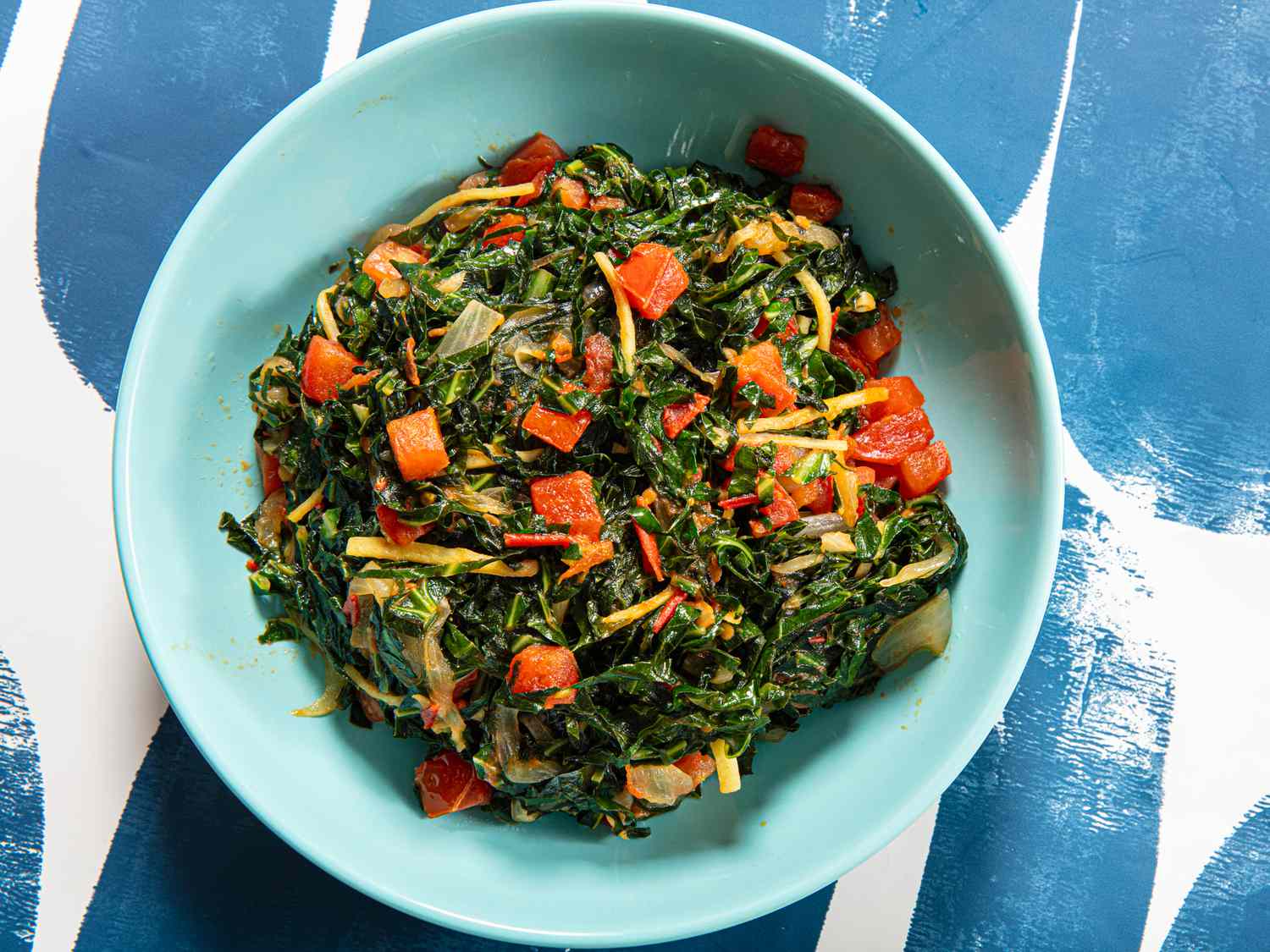
[ad_1]

Why It Works
- Cutting the collard greens into narrow ribbons and removing their stems speeds up their cooking time.
- Tomatoes, onion, and ginger add fresh, vibrant flavors to the dish.
Sukuma wiki—sautéed collard greens typically cooked with a fragrant combination of onions, tomatoes, and ginger—is a popular dish in Kenya and one of my favorite ways to eat dark leafy greens. While most kids have to be forced to eat their green vegetables, I have fond memories of eagerly eating these simply prepared collard greens alongside ugali (cooked cornmeal), both of which my Kenyan grandmother would prepare for me.
Serious Eats / Amanda Suarez
At local markets in Kenya, sukuma (collard green) vendors hold a tight bundle of the fresh stemmed and rolled leaves in one hand while carefully shaving off ribbons of greens. Then they gather the shaved greens into bags for customers to purchase to make sukuma wiki at home. Each vendor has their own preferred cut that shoppers select from, sometimes sliced as thick as 2-inch wide ribbons and others finer than angel hair pasta. The convenience of being able to buy collards this way adds to their popularity: most of the prep is already done for the home cook. The prepped sukuma is as much a staple go-to convenience item in Kenya as bagged baby spinach is in the U.S.
Serious Eats / Amanda Suarez
In Swahili, “sukuma wiki” translates to “push the week”, referring to the dish’s ability to stretch throughout the week until payday, thanks to the abundant availability and affordability of greens in East African countries such as Kenya, Tanzania, and Uganda. It is simple to prepare for any night of the week—requiring mere minutes in a sautée pan—while it is also nutritious, and a great and relatively cheap way to bulk up a meal. Here are a few tips for how to prepare and add flavor to sukuma wiki when cooking at home.
Tips for Cleaning and Cutting Sukuma Wiki
While most American supermarkets sell collard greens whole rather than pre-sliced like in the food markets in Kenya, if you follow my tips, washing and cutting the greens is still relatively easy. Don’t be tempted to save time and skip washing the greens. Bunched collard greens, like any type of dark leafy green that is grown in the ground, can have residual dirt that when left unwashed before cooking, can have an unwelcome gritty texture. Avoid this by taking the few minutes to fill a large bowl of water, then dipping the individual leaves briefly into the water and rubbing them clean before transfering to a colander to drain. A quick drain is all the leaves need for easier handling when slicing. It’s OK if the leaves are not completely dry when they hit the skillet. Any residual moisture will promote initial steaming and quickly cook off.
The next crucial step when preparing the greens for cooking is to remove the fibrous center stalk that runs through the middle of each leaf. The stalk is too tough to soften in the short cooking time, so it’s best to just remove and discard or compost them for this dish. Once cleaned and trimmed, stack a few leaves together and curl into a tight coil before running your knife through the greens to form thin ribbons.
Simple Flavor Additions for Sukuma Wiki
Each Kenyan has their own favorite combination of aromatics and spices to season the greens. Kenyan versions always include tomato and onion—a classic aromatic pairing found throughout Kenyan cuisine, but beyond that the flavors can vary slightly. Beef or chicken bouillon powder is a common seasoning used for its meaty umami flavor that’s so loved in the country. The duo of garlic and ginger is widely used in versions of sukuma wiki in coastal Kenya, where the cuisine has a strong Indian influence.
In my version, I keep the flavor profile simple, skipping the bouillon powder and garlic. A light sprinkle of salt, fresh tomatoes, onion, and ginger are the only flavorings I use. I love how ginger brightens and adds a pop of assertive peppery flavor to balance the earthy greens. The combination is simple, bright, and completely satisfying.
Serious Eats / Amanda Suarez
But don’t feel limited by the aromatics I’ve selected here. Use this as a starting point to be creative and add your own preferred flavors, whether it’s the simple addition of minced garlic, a touch of heat from red chile flakes to finish, or a squeeze of lemon juice before serving. Whatever flavors you choose to enhance these sautéed collard greens is up to you, but I recommend keeping the combination simple.
I’ve included time ranges for both crisp-tender greens as well as a longer sauté time for more tender greens, which is how I prefer to enjoy my sukuma wiki. Whether you prefer your greens velvety soft as I do, or still with a bit of bite, these greens come together quickly and pair well with almost any protein, including chicken, fish, and beef. Or enjoy sukuma wiki as my grandmother and I do, as a light meal alongside Kenyan ugali (cooked cornmeal) or another simple starch such as rice, or chapati.
[ad_2]